Acne around the mouth is a problem that plagues many young people, most often girls. Everyone wants to look beautiful, but at the same time, if the area around the mouth is strewn with acne, it is simply impossible to achieve beauty. That is why many people are interested in what causes this problem and, of course, how to cure acne around the mouth. This is exactly what the article will be about.
Acne and perioral dermatitis
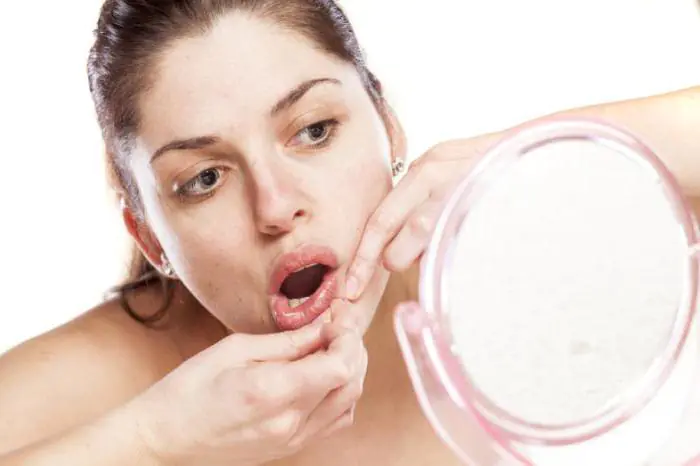
If you have acne around your mouth, then the first thing you should do is determine what is happening to your skin. The fact is that the situation may turn out to be diametrically opposite. These can be either regular acne or symptoms of a disease called perioral dermatitis, which will be discussed below. But first you need to deal with a simpler option. If pimples around the mouth appear pointwise and periodically, then this is not a disease - these are the most common acne and ulcers. The cause of their occurrence is clogged pores, and this is caused by poor personal hygiene. You just need to purchase products with which you will care for your facial skin and use them constantly. Then acne will not appear, and you will achieve the beauty effect you have always dreamed of. However, rashes are not always caused by insufficient or improper care. Many people who regularly take care of their skin still develop pimples around their mouth and chin. What could be causing this?
Disease
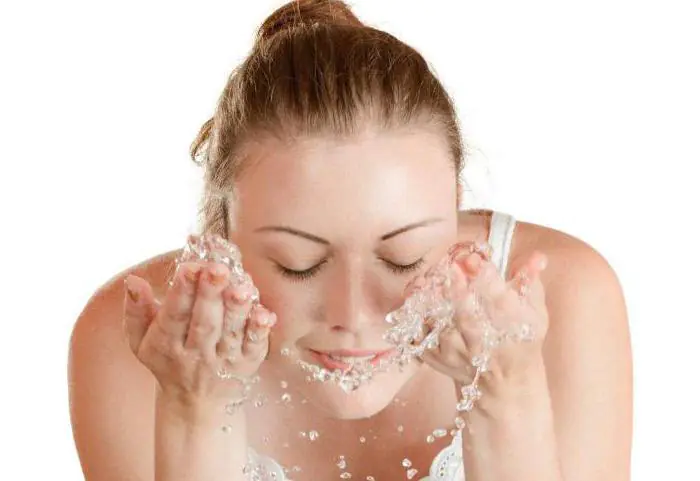
So, if you take proper care of your facial skin, but the rashes around your mouth do not disappear and are widespread rather than local, then the situation is more complex. The fact is that you most likely have perioral dermatitis - a disease in the field of dermatology that requires attention on your part. However, why do these pimples appear around the mouth? The reason for this phenomenon, unfortunately, has not yet been established - there are only a number of assumptions, which you will read in this article. A distinctive feature of this disease is that its signs are observed exclusively in the area of the nasolabial triangle - random pimples do not pop up on the cheeks, neck or anywhere else. That is why the disease is called perioral dermatitis, that is, one in which the rash spreads around the mouth.
What is this dermatitis?
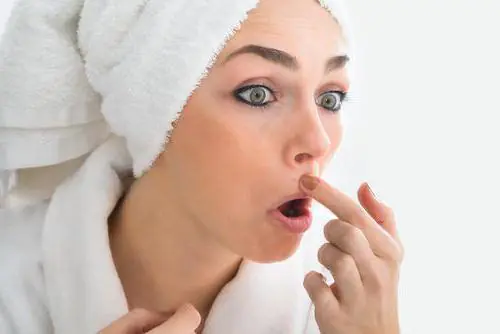
Steroids
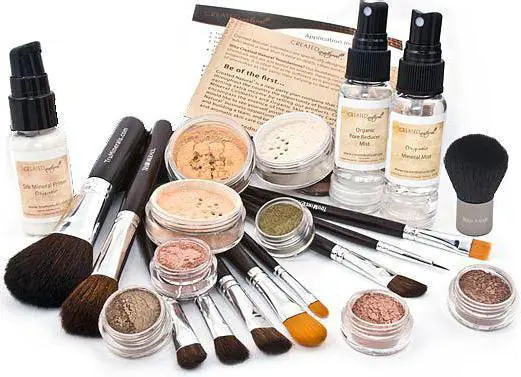
No, we are not talking about using steroids directly. If you have acne around your mouth, it's worth paying attention to whether your skin care products contain these substances. Facial creams and various ointments often contain prednisolone or hydrocortisone, which cause irritation in some people. Therefore, you should carefully study the composition of your products and try to stop using them for a while to determine whether they are the cause of the disease. Please note that the rashes do not disappear immediately after you stop using the cream that causes them to appear. Most often, the phase of active growth of acne is observed first, that is, there may be even more of them, they will become redder, and the sensations will become even more painful. But after a short period of time, this phase passes, and after it, the pimples gradually disappear from your face.
Cosmetics
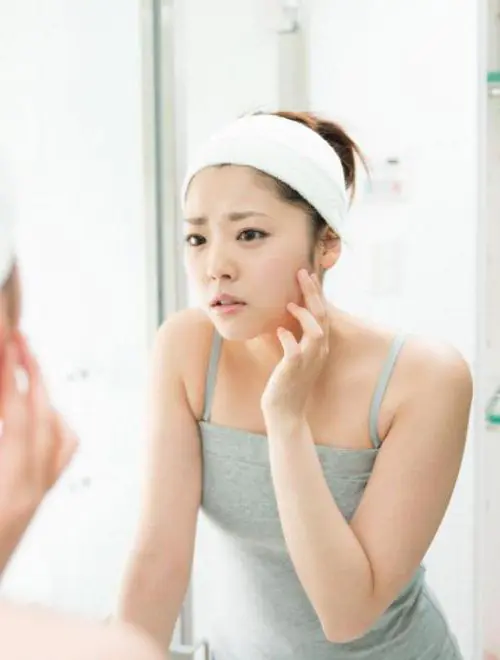
Small pimples around the mouth can also appear when using various cosmetic products. The range of these products is quite wide, but the cause of this disease is most often foundation, and there are also frequent cases when perioral dermatitis appears due to the use of certain makeup removers. In this case, you need to do the same as in the previous one - stop using specific products for a while to see if this will affect the acne around the mouth. The reason (in women this problem is observed much more often, since they use much more cosmetic products) is clear? Great! Take note, fight, and we move on.
Natural influence
It also cannot be ruled out that the occurrence of acne in the mouth area was caused by certain external factors, in particular natural phenomena. Among them, perioral dermatitis is most commonly caused by strong winds or excessive exposure to sunlight. It's not as easy to figure out as you'd like, but in most cases, if you just stop going out in the sun for a couple of days, your pimples will begin to fade, so you can quickly figure out whether something is causing your problems.
Toothpaste

Now you know the main reasons why acne around the mouth can occur. However, many doctors also talk about toothpaste that contains fluoride. By itself, in most cases, it cannot cause this disease, but if you have already developed it, then using such a paste can lead to unpleasant consequences. Fluoride intensifies the disease, pimples around the mouth begin to increase in size, become brighter, and the discomfort becomes more pronounced.
Infection
This disease can also be caused by a skin infection. This is one of the cases when you should not experiment or try to cure yourself - it is better to immediately consult a doctor who will prescribe you the necessary medications. If you self-medicate, you can trigger the disease and bring yourself to a much more serious condition. Remember that acne goes away without a trace only if you get rid of it quickly. If you delay, then after healing, traces will remain at the site of the rash that will spoil your appearance.
Hormonal background

It's no secret that hormones can greatly affect the health of the body as a whole and its individual organs and systems in particular. In some cases, their fluctuations affect the condition of your skin. As in the case of cosmetics, this reason most often causes the appearance of defects in women - acne around the mouth can appear during the menstrual cycle or during pregnancy. However, when hormonal levels normalize, acne also disappears. As in the previous case, in case of hormonal imbalances, you should not try to deal with the problem on your own - it is best to contact a specialist who will accurately determine the specific cause of the disease, and then prescribe exactly the medicine that will most likely help you.
Contraceptives
Well, the last reason why you may experience perioral dermatitis is taking oral contraceptives. This point is closely related to the previous one - the fact is that such drugs lead to a strong change in hormonal levels, which, as you have already learned, can lead to the appearance of acne around the mouth. In this case, you should contact a gynecologist to choose the means of protection that will not cause a similar reaction in your body. It would also be a good idea to pay a visit to a dermatologist who will help you eliminate the effects of the disease from your face.
Treatment
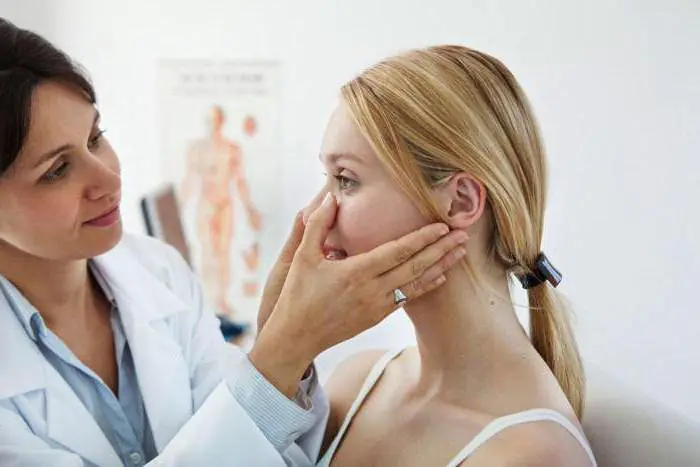
So, now you know the main causes of acne around the mouth, and therefore it’s time to put this knowledge into practice. What should you do if they start appearing on you? First of all, you need to determine the extent of the lesion. If there are few acne, they appear not only around the mouth, but also on other parts of the face, and also eventually “mature” - this means that the problem lies in personal hygiene, that is, in the lack of it. Pores become clogged and need to be cleaned using special skin care products.
However, if the pimples are located exclusively around the mouth, there are a lot of them and they do not look like ulcers or acne, then you have perioral dermatitis. If the disease has just begun to manifest itself, it is worth trying home methods - avoiding creams containing steroids, certain types of cosmetics, as well as toothpaste with added fluoride. Pay attention to the environment, weather factors and monitor how certain of your actions affect the condition of the skin around your mouth. If you can’t get rid of acne at home, don’t delay - go to a specialist, otherwise you will jeopardize not only your health, but also your appearance in the future, since acne may leave unsightly marks. A dermatologist will help you sort out your problem, he will find out why you have these acne, and will also prescribe a specific course of treatment or write a referral to the appropriate specialist. Depending on the specific cause of the disease, the treatment method is selected. Special hormonal drugs are used to stabilize hormonal levels, and antibiotics are used to treat infections. So if you are convinced that the cause is not your cream or the environment, go to the doctor immediately. This way you can quickly and effectively overcome the disease and regain your beauty.
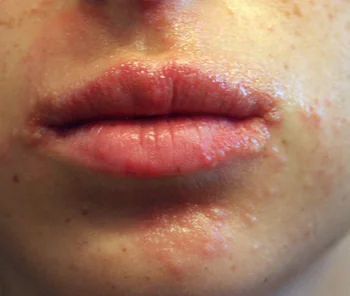
Quite a large number of guys and girls and even adult men and women are now suffering from the problem of acne around the mouth. Women mostly get acne due to hormonal fluctuations and are usually found around the mouth, jawline and chin area. When it comes to removing acne around the mouth. , then there is no definitive cure since what works for one person may not work for another.
Pimples around the mouth and chin: causes
The only good news is that for most people, acne around the mouth and chin area is preventable. This is because in about 90% of those who suffer from acne around the mouth, such acne can be attributed to the use of the wrong beauty products, which may include oily lip balms. , sulfate-rich toothpastes, cosmetics, etc. Also, women who tend to sleep with their makeup on are most likely to suffer from such acne.
In the remaining about 10% of sufferers, acne around the mouth and chin area can be related to hormones, stress, as well as other health conditions. They are usually more difficult to treat and require a multifaceted approach to treatment.
Most women suffer from hormonal acne throughout their lives, as teenagers at the onset of puberty, after childbirth due to changes in hormones and during menopause.
A dermatologist can help determine the exact cause of oral acne. Accordingly, a person may need to change brands of toothpastes or lip balms, wash their face at least twice a day with warm water and acne-specific cleansers, and then follow a makeup removal routine, especially during sleep.
The main causes of acne around the mouth and chin
Here are some of the main causes of acne around the mouth and chin:
- Lip Balm Fragrances and waxes in lip balm products can clog pores and irritate hair follicles, leading to increased sebum production that can cause acne around the mouth.
- Cell Phone Mobile phones and other tech accessories can collect and accumulate dirt, sweat, bacteria and oil from the face and hands and thus act as a trigger for acne when they come into contact with your mouth and chin area.
- Toothpaste Sodium lauryl sulfate, used as a spattering agent in toothpaste, can also clog skin pores, leading to pimples around the mouth and chin.
- Stress and Nervous System Disorders According to many dermatologists, stress does not cause new acne breakouts around the mouth or anywhere else on the body, but it can make existing acne outbreaks worse.
- Certain medications Pimples around the mouth can occur as side effects to certain medications Corticosteroids and lithium-based medications are common culprits in causing such inflammation
- Waxing Waxing can both irritate the hair follicles and create a breeding ground for bacterial action, leading to inflammation and ultimately acne.
- Comedogenic Face Creams Thick moisturizers and skin care products, especially those with an oily texture and those containing thick wax, can clog skin pores, leading to breakouts around the mouth, chin, nose and other areas of the skin.
- Hormonal Fluctuations Any stage of our lives (eg: adolescence, menopause, ovulation, pregnancy) or medical condition that causes testosterone (male hormone) fluctuations can be a major cause of acne in the mouth and chin area.
Pimples around the mouth or herpes
Acne around the mouth should not be confused with herpes; If pimples occur around the lips, they can easily be confused with those caused by herpes. There are some significant differences that can help you differentiate between pimples around the mouth and herpes.
Firstly, the appearance of acne is closely related to the hair follicle, and since the lip does not have hairs, bumps that occur directly on the lip or lip line are most likely not even herpes, but bedsores.
Secondly, herpes appears as clusters of soft, fluid-filled blisters, while oral pimples around the mouth and chin usually present as free-standing, persistent, white or red bumps. An exception applies to cystic acne around the mouth, which is characterized by tender, painful lesions, but they also have a characteristic appearance that is different from herpes.
Treatment of acne around the mouth and chin
The skin around the mouth area is quite sensitive, so treating adult acne in this area requires special care. Here are a few steps to take to ensure that adult acne around the mouth is treated quickly:
- Always wash and dry the mouth and chin area thoroughly after eating or consuming acidic foods and drinks.
- Never touch pimples and sores around the mouth as this will spread bacteria causing breakouts in healthy areas.
- Remove surface oils and makeup every night using a good cleanser such as salicylic acid lotion.
- Use oil-free moisturizers throughout the day and avoid overexposure to the sun. This is an important step to avoid acne around the mouth.
- Always keep an acne medication that treats the spot and apply it to acne-affected areas around the mouth and chin area. They usually contain salicylic acid or benzoyl peroxide and can treat zits quickly to prevent scars.
- For adult acne around the mouth and chin, retinol products can be very effective in treating acne in these areas. They contain vitamin A derivatives and can help unclog pores to treat existing blackheads and prevent new ones from appearing. A thin layer applied nightly can help reduce existing imperfections while preventing new gaps. Retinol is available by prescription and also over the counter.
- Additionally, a dermatologist can also recommend the right chemical peels, laser treatments, and other topical products to treat and reduce acne around the mouth.
Your doctor can determine treatment based on the severity of your condition. In some cases, using mild soaps and stopping the use of heavy skin creams and fluoridated toothpaste may relieve symptoms. Medications may also speed healing.
The American Osteopathic College of Dermatology recommends stopping the use of topical steroid creams or nasal sprays that contain steroids, if possible. These products may worsen symptoms. However, it is important to talk to your doctor before you stop taking any medications.
Acne around the mouth is difficult to treat and can take months to heal. Research suggests that even after several weeks of treatment, the condition may get worse before it gets better. In some people, oral dermatitis becomes chronic.
How to get rid of and how to treat acne around the mouth
Medications your doctor may prescribe to help get rid of acne around the mouth and chin include:
- topical antibiotic medications such as acne metronidazole (Metrogel) and erythromycin ointment
- immunosuppressive creams such as Ovante cream
- topical anticancer drugs such as adapalene or azelaic acid
- oral antibiotics such as doxycycline, minocycline or even isotretinoin for more severe cases
As the causes of oral dermatitis and acne around the mouth and chin vary, there is no surefire way to avoid them. However, there are some things you can do to help ease the problem or keep it from getting worse:
- Avoid steroid creams and even ointments unless specifically prescribed by your doctor.
- Do not use heavy makeup or skin creams. Ask your doctor about which moisturizers are acceptable to use.
- Switch to gentle cleansers and moisturizers. Ask your dermatologist for recommendations on products that are best for your skin.
- Limit the amount of time your skin comes into contact with elements such as: UV rays, heat and even wind, which can aggravate oral dermatitis Some of the medications that are used to treat oral dermatitis can also make the skin sensitive to the sun Remember to protect skin if you will be in the sun for a long time.
Cleansing your face also helps remove any surface oils or bacteria that have accumulated during the day, hence it is a suitable way to get rid of acne around the mouth.
Swipe a toning product over clean skin to tighten pores and prevent dirt and oil from entering. Use an oil-free moisturizer to hydrate skin and maintain a balanced complexion. Finally, when breakouts occur around the mouth, treat the blemish area as soon as pimples appear by wiping with a product containing benzoyl peroxide or salicylic acid to reduce the breakthrough time.
Finally
Acne on the chin around the mouth and jawline can be a nuisance for both men and women. However, it is also treatable and with the right approach, such acne can be eliminated even within a month. Therefore, we hope that this guide will help you get rid of acne. around the mouth once and for all!
Acne on the chin appears as the body grows. Sometimes acne does not disappear after puberty or appears after some time. Why is this happening? The article discusses the causes of rashes and how to get rid of them.
Types of acne
Acne is a hair follicle disease that affects men and women. Acne is divided into groups:
- comedones - black and white dots;
- papules – usually called pimples;
- pustules - with purulent contents;
- cyst - deep subcutaneous, intractable acne.
Causes of rashes
Teenage acne is associated with hormones and goes away on its own after puberty. At this time, the skin is treated with salicylic acid or calendula tincture. For small rashes, such drugs are enough. If there is a large accumulation of comedones, a mask against teenage acne recommended by a cosmetologist will help.
External reasons
Adults determine the cause of the rash before cleansing their face. With a mixed type of epidermis, the area with excess fat content may be in the chin area. The sebaceous secretion on the surface of the epidermis mixes with dust, cosmetics and clogs the pores. The same thing happens with oily skin. Acne is rare on dry epidermis. Many rashes indicate a disease inside the body.
Touching your face with clothing or hands spreads bacteria. If you have acne, do not wear things with a large neckline, scarves or scarves. If it is impossible to refuse, they give preference to soft natural fabrics and wash them daily. The habit of touching your face with your hands transmits bacteria, so take care of yourself and prevent the spread of microorganisms.
Poor-quality or unsuitable cosmetics for the epidermis clog enlarged pores and cause acne on the chin. Manufacturers specializing in cosmetics for problem skin offer a line of facial care products. Beauty salons provide the first consultation free of charge. If it is not possible to visit a cosmetologist, choose cosmetics from well-known companies specializing in medicinal products. The MAX FACTOR company has proven itself to be the best.
Working with fuels and lubricants, inflammatory processes. Vapors of harmful substances penetrate the pores and cause a rash and purulent acne. Together with a dermatologist, the possibility of further work in difficult conditions is decided.
Internal reasons
Eating fast foods, French fries, candies, and processed foods leads to excess weight and metabolic problems. The body converts proteins and carbohydrates from such foods into fat. Subcutaneous fat does not allow the epidermis to work fully, and dehydration occurs.
Fatigue, stressful situations, neuroses disrupt metabolism and lead to illness.
Rashes of certain diseases:
Rosacea affects people aged 30 years and older. The condition is characterized by rosacea, but not comedones.
rosacea
Pseudofolliculitis affects people who shave. The hair grows inside the follicle and a red itchy bump appears. Sometimes Pseudopholiculitis occurs on acne-prone skin.
pseudofolliculitis
Folliculitis - inflammatory elements appear on different parts of the body and on the chin. These are not acne, but inflamed follicles. If the disease progresses, doctors prescribe antibiotics.
Gram-negative folliculitis is raised blisters filled with antibiotic-resistant bacteria. Appears on the skin of patients treated with antibiotics for a long time. Tests help identify bacteria. The doctor prescribes treatment.
Acne on the chin appears due to a parasitic disease caused by excessive growth of demodex mites. The disease manifests itself with itching, redness, rash, and acne. The parasite lives in 90% of the population and does no harm. Changes in tissue cover occur in patients with a genetic predisposition to the disease or who have a certain defect in the body's defense system. A dermatologist takes a scraping of the epithelium for analysis to diagnose demodicosis.
demodicosis
Acne on the chin appears due to diseases of the ovaries, adrenal glands, intestines, and endocrine system.
Acne on the chin in men
All the problems described above are sources of papules and pustules in men. In addition, acne on the chin appears due to diseases of the pelvic organs. If there is a large accumulation or constant appearance of inflammatory elements, men check:
- rectum;
- bladder;
- prostate gland;
- seminal vesicles;
- urethra;
- penis;
- testicle;
- scrotum
There are many connective tissues in the pelvis, the organs are located close. A diseased organ affects the functionality of others.
Acne on the chin in women
The causes of rashes on the chin are the general problems described above and the pelvic organs:
- uterus;
- the fallopian tubes;
- ovaries;
- bladder;
- rectum.
The pelvic organs are provided by a complex of hormones, including progesterone, estrogens, prolactin and others. These same hormones control the mammary glands. In case of diseases of the reproductive system, the hormonal balance is disrupted and changes occur in the mammary glands. The pelvic organs and mammary glands are connected, therefore, rashes on the chin signal breast problems.
If you divide the face into zones, each projects a specific organ of the body, says Chinese medicine. Small rashes indicate the onset of the disease. Purulent, subcutaneous pimples with red or blue nodules indicate a serious problem. A rash on the chin indicates an organ that should be checked by a doctor. Acne is removed after examination and treatment of internal organs.
Acne on the chin is the result of problems with internal organs
What problems should you pay attention to based on the location of the pimple? Below is a diagram and explanation.
- Pimples are located under the base of the lower lip at the top of the chin, check the small intestine.
- Irritation, redness and acne on the left outer side of the chin indicate problems in the area of the poupart and left inguinal fold.
- For redness, peeling, dryness and pimples on the left side of the mental fold, women check the left ovary, men check the left testicle.
- Pay attention to the right ovary or right testicle, with acne or other irritation on the right side of the chin near the mental fold.
- Pimples or age spots on the right side of the chin, in the area of the fold running from the corner of the mouth to the lower jaw as a continuation of the nasolabial fold, a sign of disorders of the lymphatic system in the groin.
- Pimples and blackheads on the left side of the chin under the lip, at the top of the bone tuberosity, ask you to pay attention to the left mammary gland.
- The right mammary gland is checked for rashes on the right side of the chin under the lip.
- If there are problems with the mammary glands, pain sensitivity increases at the site of inflammation, redness or irritation appears.
- Pimples in the center or bottom of the chin, redness and soreness, indicate problems with the perineum, uterus or prostate gland.
- The pubic symphysis is checked if acne appears and pain occurs when pressing in the mental fossa.
Which doctor should I consult?
First of all, they contact a therapist and ask to schedule an examination. If the doctor finds abnormalities in health through analysis, he will refer you to specialists to confirm the diagnosis and prescribe treatment.
Cosmetologist – corrects aesthetic and medical skin problems. A cosmetologist-esthetician does not diagnose or treat diseases. The goal is comprehensive care. A cosmetologist eliminates the causes that lead to skin defects.
Dermatologist – diagnoses and treats skin diseases.
Gynecologist – diagnoses and treats female reproductive organs. Since gynecology is related to hormones, there is a specialist. For acne, additionally consult a gynecologist-endocrinologist.
Gastroenterologist – treats diseases associated with the gastrointestinal tract.
Nutritionist – deals with issues of rational and healthy nutrition for healthy and sick people. Selects a personal diet. Metabolic disorders, excess weight, allergic reactions, problem skin - the competence of the doctor.
Endocrinologist – treats and diagnoses endocrine system failure. The task is to eliminate the disease and its consequences. The doctor restores metabolism, hormonal balance and more.
Allergist – diagnoses and treats allergic diseases, which are based on the immune system’s response to external irritants. The task is not so much to cure an allergic person, but to teach the correct behavior.
Treatment options
Acne is removed with external preparations after the underlying disease has been eliminated. Clean your chin by entrusting it to a specialist or doing it yourself using home methods.
Cosmetic methods
Before the cleansing procedure, the cosmetologist uses special creams and scrubs that expand the pores. Previously, steam baths and hot compresses were used. New technologies protect against the formation of rosacea. Using sterile instruments, the plugs clogging the pores are squeezed out. Acne wounds are treated with an antiseptic solution. Finish the procedure with a tightening mask.
Clear acne on the chin yourself at home. Mechanical cleaning procedures are described in detail in the article on the website. Before manipulating the face, hands are treated with an antibacterial agent. Finish the procedure with a tightening mask. For sensitive and dry skin, facial cleansing is contraindicated; use pharmaceutical preparations.
Medication methods
- Zinerit lotion contains zinc and erythromycin. Zinc restores the functioning of the sebaceous glands, and erythromycin gets rid of microorganisms.
- Gel Baziron removes acne.
- Skinoren relieves acne.
Acne on the chin is a consequence of a lack of vitamins or minerals in the body. Proper nutrition compensates for the lack of nutrients. Additionally, purchase a complex of vitamins and minerals at the pharmacy.
Folk remedies
Tar soap eliminates inflammation and enhances regeneration. Soap and tar dry out acne and eliminate oiliness. Used for the prevention and treatment of psoriasis and dermatitis. A natural anti-inflammatory product effective for problem skin.
Washing your face with a special composition will help with acne and oily shine. 30 ml of 1% kefir is mixed with half a glass of water, one teaspoon of dry mustard and two soda. Wash immediately after the composition stops foaming. Use morning and evening, finally rinse your face with cool water.
For problem skin with post-acne, washing with cream is suitable. Mix a teaspoon of cream and lemon juice in a glass of water. At the end add a tablespoon of sea salt. Wash your face at night. Finish the procedure with cold water.
Nettle lotion helps with subcutaneous acne. Infuse a glass of vodka and nettle leaves in a dark glass vessel. After ten days the lotion is ready. In order not to damage healthy epithelial cells, the product is applied locally to the elements with a cotton swab.
Use lemon lotion to wipe your face. The juice of half a lemon is added to a glass of boiling water. Use twice a day. Store in the refrigerator.
The video contains expert advice.



